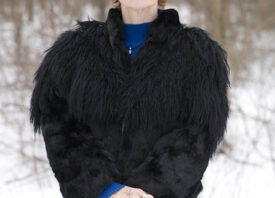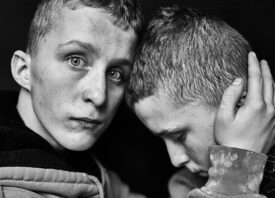Search this site
Sexual Assault Survivors in Nigeria Collaborate to Make Powerful Portraits



In June 2020, the governors of Nigeria’s 36 states declared a state of emergency on rape. The Nigerian Governor’s Forum took action after women’s group spoke out following the brutal rape of students including Uwaila Vera Omozuwa, who died after being attacked in a church on May 27.
According to a 2014 UNICEF study, at least 25% of Nigerian girls have been sexually assaulted before the age of 18 — though it is a crime that has long been woefully underreported. “The truth is, the pain of women and girls — including the kind of pain caused by sexual violence — simply isn’t a big deal in Nigeria,” OluTimehin Adegbeye wrote in a September 4 Op-ed in The New York Times titled, “Nothing Happens When Women Are Raped in Nigeria.”
Adegbeye continued, “If anything, generalized female pain is a fundamental aspect of our social order. The more abuse a woman is able to meekly accept, the more virtue she is accorded by the people around her. And those who speak out against abuse are put back in their place.”
Such conditions make it all the more important to speak out and challenge the status quo, humanize the victims, center their stories, and advocate for restorative justice. In the series “Legal Rape,” Nigerian photographer and social activist Emeke Obanor does just this. By creating a series of collaborative portraits with survivors, Obanor creates a space to consider women and girls as individuals worthy of the basic rights and protections afforded to all.
The only way to create change it to dismantle pathological behaviors that have been normalized to protect predators from prosecution of their crimes. “The culture aspect includes gender norms that validate men as sexual pursuers and attitudes that view women as sexual conquests by which manhood is legitimized and women are objectified, as sexual objects to be owned, used, consumed, and even sexually abused by the ‘entitled’ male,” Obanor writes in his artist statement.
“The society on their part undermines the emotional trauma experienced by rape victims and thus become unsympathetic and sees it as a norm…. [Meanwhile] Some of the victims truly suffer uncomfortable memories such as nightmares, flashbacks, suicide thoughts and feelings of guilt. It can also manifest in physical ways, like chronic pain, intestinal problems, muscle cramps, paralyzed vocal cord, or as in TY case, sleep disorder.”
Recognizing the first step in healing is to break the silence, Obanor works with rape survivors to create a safe space where they can begin to heal in a process that allows them to slowly reclaim their voice and agency. Here, Obanor shares his work as an artist, activist, and advocate as a man speaking back to the patriarchy against the crimes it inflicts.

To begin, could you speak about how you got into photography and how it can be used as a tool of activism?
“It started as just a hobby, something I did to capture those moments in time peculiar to our environment. Along the way, I came to realize that it can also become an avenue to present the topical issues of our days in a manner not usually done over here. Issues that have not always been shown in this manner, forced marriage, child labor, gender violence are something cloaked in tradition and custom. Stark photos force us to confront these issues.”
Could you speak about the cultural expectations of men and women in Nigeria, and when you began to recognize the harm that patriarchy and misogyny cause?
“Nigerian social and economic life is still dominated by traditions and customs. Although we may have over 250 different tribes, each with their customs and traditions, life here is still overwhelmingly dominated by a patriarchal system wherein many cases women are regarded as possessions.
“In many cultures, widowed women are ‘inherited’ by relatives of the husband, much the same as other properties. A close relative of mine refused to be ‘inherited’ in such a manner and was expelled from the family, while all the late husband’s possessions were shared amongst the males of the family. It was at this point I decided to start highlighting such issues through the medium of documentary photography.”
Could you speak about the inspiration for the “Legal Rape” series?
“’Legal Rape’ came about through the counseling group at our local church. My friend attends the counseling group and told me stories of several women complaining about being forced, either by their husbands or acquaintances. Few women here really understand the legal concept of consent and I felt it was an issue that needed to be brought to light. Rape in any form is illegal but there is a stigma attached to it, so when a society seems to normalize it, few of the victims realize that it is illegal.”

Could you speak about the process for making the portraits themselves?
“The decision on where and how to photograph the subjects is often determined by both the topic we are trying to present as well as the subjects themselves. I try to get the subject to understand the topic, why we are doing what we are doing, and what we hope to achieve. The subject sometimes have concerns about blowback from their participation, and in such cases, we try to hide their features to protect them.”
I imagine that the experience of revisiting these traumatic memories could have been retraumatizing for your subjects, and even by extension to yourself in bearing witness. Could you speak about what occurred in creating a safe space for them to speak out and acknowledge the harm done?
“The common feature of all my projects is trying to reach a common understanding of what the subject is experiencing. I spend a lot of time with the subject and on the topic and we try to reach a point of trust and understanding of each other. A lot of times privacy and counseling are involved; even after the projects, we try to follow up and provide assistance and feedback to the subjects.”
Could you speak about the impact of making this work, be it on yourself, your subjects, or people who have seen it and shared their experiences with you?
“It has had a great impact. It’s like a journey and all of us on that journey — both myself, my collaborators, and the subjects themselves — have come out transformed on the other side. At the beginning, it’s just trying to understand the topic and the subject but along the way, through the process, we all become immersed in the experience and I believe we come out changed and better for it.”
Lastly, could you speak about the transformative power of facing trauma and speaking openly about it in a culture that silences or discredits victims?
“Confronting entrenched traditions and customs can be very challenging and there are many who will view your work as a direct attack on their culture. But we still have to forge ahead and try to present them with the reality of those facing the effects of these repressive and oppressive cultures. We hope to change minds eventually.”



All images: © Emeke Obanor


